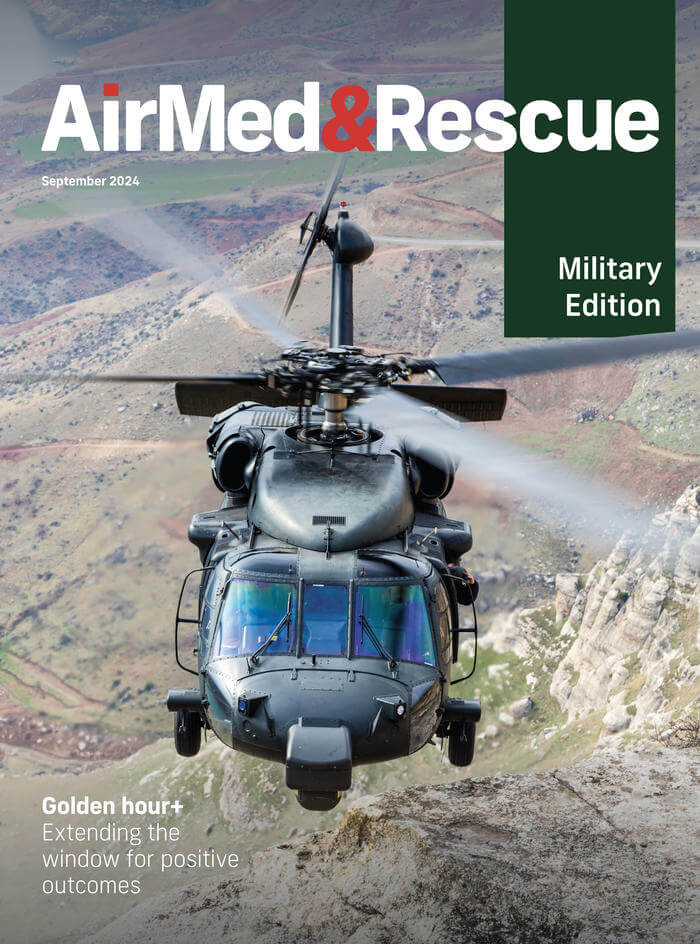Industry voice: Primary ECMO retrieval in the Pacific Northwest

Airlift Northwest brings additional critical care transport options to the US region
In May 2018, Airlift Northwest, the University of Washington School of Medicine’s (UW Medicine’s) air medical transport program, along with the UW Medicine extracorporeal membrane oxygenation (ECMO) team completed their first extracorporeal life support transport of a patient on veno-arterial (VA) ECMO who needed a heart transplant in Seattle.
ECMO is a medical procedure that redirects blood for mechanical gas exchange and returns it to support a patient’s failing lungs and/or heart. With improvement of technology, this therapy improves patient outcomes. During the Covid-19 pandemic, it was recognized that there was a growing need for patients to be placed on ECMO prior to transport while at facilities that were not equipped to perform this procedure. This is termed primary cannulation or primary ECMO transport. Transporting these patients is logistically complex and risky. Despite these challenges, on 18 April 2024 Airlift Northwest, along with its partners from the UW Medicine ECMO team, completed its first primary ECMO transport for a patient with severe acute respiratory distress syndrome (ARDS). Here we present the risk analysis and program implementation used for primary ECMO retrieval and transport.
Adaptability brings smoother implementation
Air medical transport functions in a highly dynamic environment, requiring both consistency and nimbleness to adjust to events out of the flight crew’s control. It was critical to ensure the expertise of the flight team was utilized (i.e. flight physiology, logistics, experience, etc.). Establishing an implementation timeline to keep the project moving forward was key. Using a project management framework, each phase of the transport was outlined with objectives, stakeholders, and key findings. Airlift’s four-phase implementation included tabletop, simulation, education, and go-live. Each of these phases acted as a plan-do-check-act (PDCA) cycle prior to go-live.
Safe and successful implementation of primary ECMO transport required the engagement of numerous stakeholders
Safe and successful implementation of primary ECMO transport required the engagement of numerous stakeholders including aviation, the administrator-on-call group, the Education Manager, the Cardiac Device Educator, the Safety Officer, the Communications Center, the Airlift Medical Director, the UW ECMO Coordinator, the UW ECMO Medical Director, the UW ECMO Specialist, and ground emergency medical services (EMS). For planning purposes, primary ECMO transport was segmented into five transport phases for the stakeholders to evaluate:
- ECMO readiness
- Notification and activation
- Mobilization
- Transport
- Return to readiness.
This provided a focus for critical evaluation through the lenses of training, safety and hazards, and quality / Commission on Accreditation of Medical Transport Systems (CAMTS) readiness. The paradigm encouraged stakeholder participation in each phase of the transport process. The project team created a process map and charter to illustrate these.

Building safety into the system
The Cardiac Device Educator completed a literature review of safety key performance indicators (KPIs) to observe during program development. In addition to feasibility and safety indicators, the literature review identified 90 adverse events with occurrence rates between 15% and 95% (due to inconsistency of data definitions). To create Airlift’s KPIs, the project team defined the KPIs by cross-referencing and standardizing data definitions using Extracorporeal Life Support Organization (ELSO) data definition language and categorizing terms into equipment, clinical, and human error. The list was refined to 22 adverse events and clinical quality metrics, ranked 1–3 based on severity. The team began recording these in Airlift’s safety management system (SMS) and electronic health record.
Principles of quality and safety management were vital to program expansion by soliciting a matured SMS. Airlift identified the most appropriate risk mitigation framework to apply to the project. The program enhanced understanding of risk by using the SMS applied to other high-risk transport types. Organizational understanding of risk supported a proactive safety approach by classifying the pre-implementation launch elements into the context of operations.
All stakeholders participated in a tabletop gap analysis exercise where over 80 different safety risks were identified and operational stop points addressed prior to go-live. This was followed with a formal risk analysis in the simulation lab and aircraft, which included completing a full primary cannulation from start of the process at activation to the end of the process with return to readiness.
These tabletop-generated lists of hazards and logistical considerations of all types were divided into transport phases. Subgroups gathered to analyze the list and define each by domain (clinical, operational, safety, legal, compliance, etc.), mitigation status (not started, in-progress, etc.), and their assigned risk level, based on Airlift’s risk assessment process. This analysis created a risk strategy, identifying risk mitigation priorities, which were added to the project charter.
Simulation was another PDCA cycle. Using the risk and gap analysis findings from the tabletop, the same team from the tabletop plus Airlift flight nurses gathered to complete the simulation. The Safety Officer observed to note areas of concern, risks, and hazards. At the end of the simulation, the team reviewed the list and documented additional comments and concerns, compared it with the tabletop results, and updated the risk strategy and risk mitigation priorities.
The risk strategy for primary ECMO transport bolstered the education already underway for secondary ECMO transport
Finally, the risk strategy for primary ECMO transport bolstered the education already underway for secondary ECMO transport. For this, each ECMO specialist and physician completes an initial ECMO simulation with an Airlift flight crew and quarterly ECMO transport simulations. These simulations include patient assessment, patient packaging, movement of the patient on ECMO to an ambulance or aircraft, an ECMO emergency, and one medical challenge. ECMO specialists and physicians are required to complete the following education and training annually: aircraft, flight, and ambulance safety; flight physiology; and air medical resource management education. They are also encouraged to fly at one of our regional bases for more experience in the transport environment. Baseline knowledge of the flight environment is useful in providing context to the challenges identified throughout the simulations.
Each Airlift Flight Nurse is required to attend an annual cardiac device and ECMO education day. This has given our crews the opportunity to learn Impella, intra-aortic balloon pump (IABP) and ECMO principles, and take a deep dive into Airlift’s clinical practice guidelines to manage these devices while the ECMO Specialist manages the ECMO pump.
Post-go-live, each of these transports is given an event review and root cause analysis for any issues that arise. Continuous improvements are made with each PDCA cycle to standardize care and improve patient outcomes.
Authors
Mikaela Hagberg, MHA, BSN, RN, CEN, CFRN
Katie Johnston MSN, CFRN, C-NPT, EMT-P
David Manley, BHS, EMT-P, MTSP-C, NHDP-BC
Matthew Plourde, MS, BSN, RN, CCRN, CFRN
Colleen Records, MHM, BSN, CCRN, CFRN
Kyle Danielson, MPH, MN, ARNP, CFRN
Brenda Nelson RN, CEN, CFRN
Jeff Richey, RN, MHA, FACHE
Richard B Utarnachitt MD, MS

September 2024
Issue
In the September military edition, discover the innovations and strategies for improving survival during the golden hour; find out about technology and training for flying through degraded visual environments; learn of the value of the mental health care for combat medics and first responders; and see what goes into the production of a quality engine to power your flight; plus more of our regular content.
Mikaela Hagberg
Mikaela Hagberg began her career in healthcare as a volunteer Firefighter/Emergency Medical Technician (EMT). Working as a first responder, she fell in love with EMS, which inspired her to pursue a career in emergency and critical care medicine. She worked at Valley Medical Center in Renton, Washington, for eight years prior to getting hired at Airlift in 2014. Mikaela is also passionate about disaster medicine. She is a member of the US National Disaster Medical System (NDMS) Trauma Critical Care Team, a federal disaster response team that provides critical, operative, and emergency care to help people during disasters and public health emergencies. As an Assistant Chief at Airlift, she works hand in hand with the flight nurses, EMS and hospitals to deliver exceptional clinical care to patients throughout the region.

